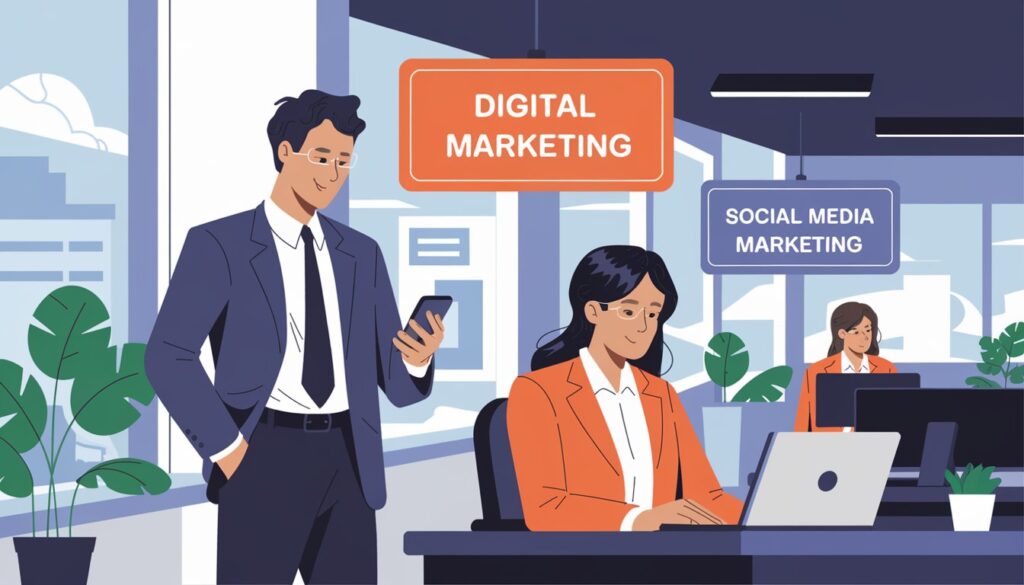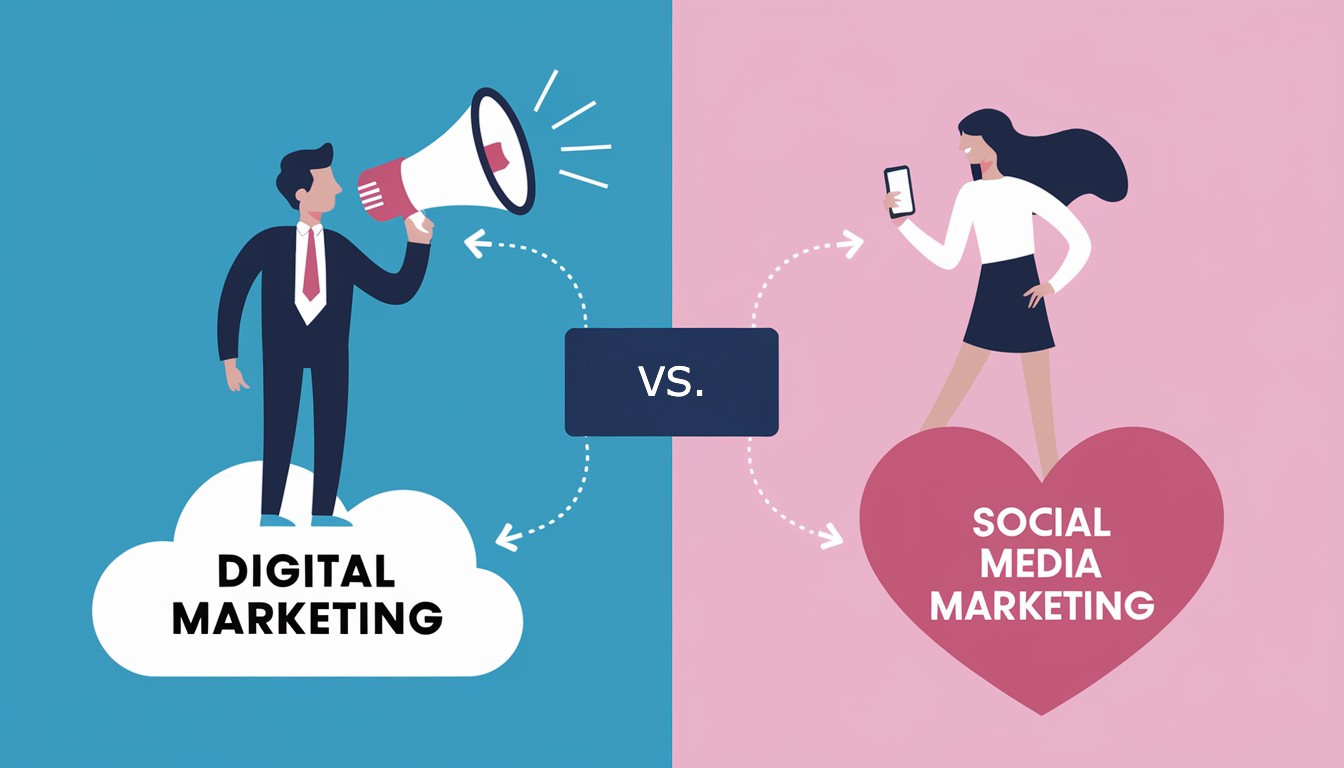In the fast-paced, ever-changing world of online marketing, standing out from the competition and reaching the right audience is more critical than ever. Businesses today face the challenge of choosing the right strategies to maximize their digital footprint.
Two of the most widely discussed approaches are digital marketing and social media marketing. Although people often use these terms interchangeably, they represent distinct yet interconnected aspects of the marketing landscape.
Misunderstanding the differences between these two strategies can lead to missed opportunities and wasted resources. By clearly understanding what sets digital marketing apart from social media marketing, businesses can craft well-rounded strategies. These strategies not only amplify their online presence but also drive meaningful engagement and tangible results.
This guide will break down the essentials of digital and social media marketing, highlighting their unique strengths. It will also show you how to leverage them for success. Let’s dive in and uncover how these strategies can transform your brand’s online presence!
Understanding Digital Marketing
Digital marketing uses online platforms to talk to today’s audiences. It includes search engine optimization, content marketing, and pay-per-click ads. These methods help build a community around a brand or organization.
Setting up websites is a big part of digital marketing. These sites act as the main place for a brand’s online presence. Email marketing campaigns are also key, letting businesses send messages directly to customers.
Search engine optimization boosts a website’s visibility in search results. Pay-per-click ads are great for fast traffic to websites. They show ads in search results and on other sites.
Social media marketing uses platforms like Facebook and Instagram to connect with people, while mobile marketing targets users on smartphones and tablets.
The U.S. Bureau of Labor Statistics says there will be a 6% increase in jobs for advertising, promotions, and marketing managers by 2032. This shows how important digital marketing is becoming in business plans. With a median salary of $156,580 in 2022, it’s a promising career path.
What Is Social Media Marketing?
Social media marketing uses popular platforms to promote brands and products. With 4.76 billion users worldwide, it’s a huge opportunity to reach people. In the U.S., 82% of Americans use social media, making it a great place for marketing.
At its heart, social media marketing is about creating engaging content. Brands make posts, videos, and stories to connect with their audience. For example, Apple’s #ShotoniPhone campaign got 6.5 billion media impressions and sold 231 million iPhone 6 units.
Influencer marketing is key in social media strategies. Brands team up with influencers to spread their message and reach more people. This, along with social media ads, helps target specific groups based on their interests and behaviors.
Social media marketing is a cost-effective way to build brand awareness and connect with customers. But, it needs constant effort. Success depends on posting unique content and engaging with the audience. Despite its limitations, social media is a powerful tool for businesses of all sizes.

Key Differences Between Digital Marketing and Social Media Marketing
In today’s digital landscape, both digital and social media marketing play crucial roles in driving business growth. While they share common goals, they differ in their approach and execution. Understanding these key differences can help businesses develop a more effective marketing strategy tailored to their needs.
- Scope: Digital marketing encompasses a wider range of channels, including email, SEO, and content marketing. Meanwhile, social media marketing focuses exclusively on platforms like Facebook and Instagram.
- Targeting: Digital marketing allows for precise global targeting across various channels, while social media marketing emphasizes real-time engagement within specific platforms.
- Effort: Social media marketing requires consistently creating content and monitoring trends, while digital marketing campaigns can automate some processes for efficiency.
- Cost: Social media marketing is often less expensive upfront but may need continuous investment. Digital marketing offers diverse strategies, some of which have higher initial costs but broader reach.
Overlapping Areas of Digital Marketing and Social Media
Both strategies aim to enhance brand visibility and drive sales. Content marketing is a shared focus, with digital marketing emphasizing diverse formats like blogs and videos. Social media, on the other hand, prioritizes shareable posts.
Maintaining a consistent brand image across all channels is essential. For example, Glossier’s cohesive approach to social media and digital platforms strengthens its brand identity.
Benefits of Digital Marketing
Digital marketing provides significant opportunities for businesses. With 92% of Americans online, companies can reach a vast audience and enter global markets cost-effectively compared to traditional methods.
A major advantage is data-driven marketing. 72% of top marketing teams analyze campaigns in real time, enabling businesses to track performance, measure ROI, and make informed decisions. Tools like Google Analytics help marketers understand user behavior and preferences.
Personalization is another key benefit. 80% of marketers highlight the importance of tailoring customer experiences. Digital marketing enables businesses to deliver targeted messages based on individual interests, driving engagement and boosting sales.
Flexibility is a standout feature of digital marketing. Spanning eight core areas, including content and email marketing, it allows businesses to execute multi-channel campaigns. These campaigns effectively reach and resonate with their audience, maximizing results.
Advantages of Social Media Marketing
Social media marketing is great for businesses wanting to grow their brand and connect with customers. 74% of people use social media to help decide what to buy. This makes it a strong way to increase sales and keep customers coming back.
It also lets businesses talk to millions of people online. This is a great chance to hear what customers think and respond to them. It’s all about quick and real conversations.
Another plus is how flexible social media marketing is. It lets you see what your competitors are doing and get your brand out there. Features like X’s Auto Advance make videos more personal and engaging. With 96% of followers interacting with brands often, posting regularly is key.
To get the most out of social media, use tools to manage your accounts. Look at the data to see what’s working. This way, you can make sure your social media fits with your bigger marketing plans and helps your business grow.

Choosing the Right Approach for Your Business
Choosing the best marketing strategy for your business is a big decision. Start by analyzing your audience. Find out who your customers are and where they hang out online. This helps you decide if social media or digital marketing is better for you.
How much you have to spend also matters. Social media is often cheaper, with 93% of marketers saying it boosts brand exposure. Digital marketing might cost more upfront, but it offers many strategies for different goals.
Think about your industry and who you’re up against. B2B companies often prefer LinkedIn, as 40% of B2B marketers say it’s great for leads. For B2C brands, Instagram or TikTok might be a better fit.
You don’t have to pick just one marketing method. Many businesses use both digital and social media to reach their audience. The goal is to find the right mix that fits your business goals and budget.

Measuring Success in Digital Marketing
Digital marketing analytics are key to evaluating campaign performance. By monitoring important metrics, companies can learn a lot about their online plans. Website traffic shows how well users see and reach a site.
It also shows which methods bring in the most quality leads, helping to make choices based on solid data.
Conversion rate optimization is vital for making campaigns work better. It shows how many visitors do what you want them to, like buying or signing up. A high rate means your marketing is doing well. But a low rate means you might need to do better.
Other key metrics include how long people stay on your site, how many leave quickly, and how often they come back. These tell you about how people interact with your site. For example, if people stay longer, they’re more interested. But if they leave fast, your site might not be right for them.
To really know if your digital marketing is working, set clear goals. Make sure they are Specific, Measurable, Achievable, Realistic, and Timely. Don’t just look at follower numbers, as they don’t tell you much. Use tools like Google Analytics to get a full picture of how you’re doing.
By keeping an eye on these numbers and working with skilled marketers, you can make your digital plans better. This will help you get more out of your marketing efforts.
Evaluating Success in Social Media Marketing
Engagement rate is a top indicator of success. A 1% or higher engagement rate on most platforms shows good audience interaction. To find this, divide total interactions by followers.
Follower growth is also crucial. Aim for a 5-10% monthly growth rate. To check this, divide new followers by the initial count and multiply by 100. This shows how your social media reach is growing.
Website traffic analytics offer deep insights into campaign success. Look at clicks, click-through rates, and bounce rates. These show how well social media drives website traffic. Tracking conversions like bookings or sales shows the campaign’s direct impact on your business.
Tools like Sprinklr provide advanced analysis, including sentiment and competitive benchmarking. These tools help refine strategies and improve campaigns in real-time. By regularly checking these metrics, businesses can make better decisions to enhance their social media marketing.
Future Trends in Digital Marketing
The world of digital marketing is changing fast. AI is making a big impact, changing how companies talk to customers. By 2025, we’ll see even more personal content online, going beyond just basic customization.
Voice search is becoming more popular. With 35% of U.S. homes having smart speakers, marketers are adjusting to reach people through voice. This opens up new ways to talk to audiences through voice-activated devices.
Personalization is still a big deal. Thanks to data, digital marketers can reach more people. AI and automation are making marketing better and more focused, helping campaigns work harder.
Augmented reality (AR) is changing how we interact with products. Big names like IKEA and Sephora are using AR for cool experiences. This trend will grow, letting businesses connect with customers in new ways.
Video content is still king. Sites like YouTube, TikTok, and Instagram Reels are leading the charge. Marketers are using video to grab attention and share messages in a fun way.
Upcoming Trends in Social Media Marketing
Social media marketing is changing fast, with video marketing leading the way. YouTube Shorts now get over 50 billion views every day, which shows how much people love short videos, especially young ones.
More people are shopping on social media now. This is because 24% of users like to find products on these platforms. Gen Z users are turning to TikTok for their searches and skipping Google.
Influencer partnerships are also changing. Nano-influencers are getting more attention, with twice the engagement of bigger influencers. This shows people want real and relatable content. With 72% of U.S. adults on social media, brands need to keep up with social media trends.
New platforms and features are also changing social media. Threads quickly gained 141 million users, and AI is making a big impact. Meta has launched 28 AI entities. These changes mean social media marketing will keep evolving, and marketers need to stay on top of it.
Conclusion: Mastering the Digital Dance — Where Strategy Meets Innovation
In today’s rapidly changing digital landscape, success depends on effectively integrating digital and social media marketing. Rather than competing forces, these strategies serve as complementary tools in your marketing arsenal. By understanding your audience, setting clear goals, and embracing innovation, you can craft campaigns that truly resonate.
As technology advances, marketers have unprecedented opportunities to forge meaningful connections with customers. Staying adaptable and leveraging the unique strengths of both digital and social media marketing enables businesses to thrive. This approach helps them succeed in the ever-changing world of online engagement, leaving a lasting impact.
Want to dive deeper into the exciting intersection of digital and social media marketing? Explore more insights and expert tips on Social Meep. Stay ahead of the curve!
